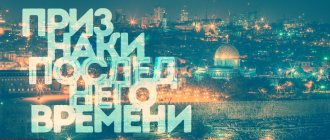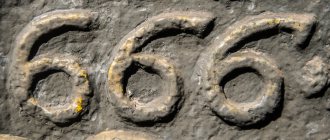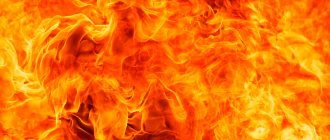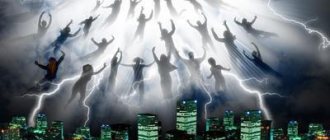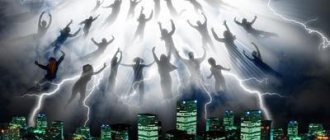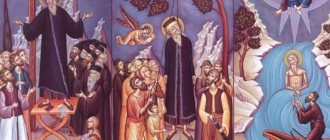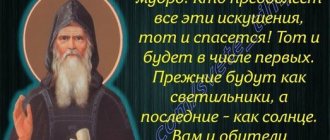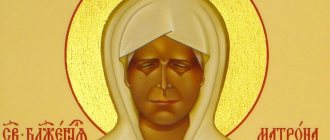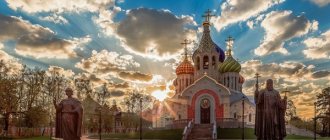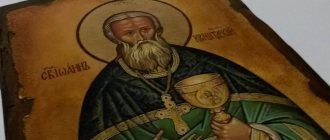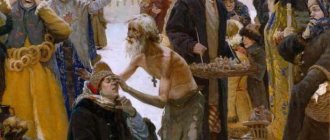| Prophet Ezekiel |
Ezekiel
(Heb.
Y'hezkel, “The Lord will strengthen”
, Greek Ἰεζεκιήλ; c. BC), prophet, one of the four great prophets of the Old Testament. Commemoration July 21, July 23 (Greek [1])
Born in Judea, in the family of the priest Busius, he came from the tribe of Levi. He was a priest.
During the second invasion of Jerusalem by the Babylonian king Nebuchadnezzar, at the age of 25, Ezekiel was taken to Babylon along with King Jehoiachin II and many other Jews.
Having settled in Tel Aviv, near the Khobar River, he married and acquired a home, but in the fifth year of his captivity he was called to prophetic service, to which he devoted his entire subsequent life.
Living during a period of severe trials for the people of Israel, he followed with a sinking heart the events that preceded the fall of Jerusalem; foreseeing the inevitable death of the city, he prepared the people for it, consoling them, at the same time, with the hope of liberation from captivity and strengthening faith in the Messiah as the true son of David.
Ezekiel's prophecies are rich in mysterious symbols and visions. He was called to prophetic service by a vision in which a divine man appeared before him on a mysterious throne mounted on a crystal-like vault and supported by the heads of four winged animals (Ezek. 1:4-28). He received the gift of prophecy through eating a book scroll, on which was written the inscription: “crying, and groaning, and grief.” The majestic vision of a field with withered bones rising to new life was a visual image of the restoration and liberation of the Israelite people. Ezekiel's prophecies end with a vision of a new temple, a new Jerusalem, and a new division of the Promised Land. All these symbols and visions had in mind the awakening of the people, who were either indifferent to simple preaching speeches, or listened to the prophet only as “an amusing singer with a pleasant voice and a well-playing musician.”
The holy prophet Ezekiel had from the Lord the gift of working miracles. He, like the prophet Moses, divided the waters of the Chebar River with a prayer to God, and the Jews crossed to the other bank, avoiding persecution by the Chaldeans. During the famine, the prophet asked God to increase food for the hungry.
According to ancient legend, he was killed by one of the Jewish princes for exposing him in idolatry. Tied to wild horses, he was torn to pieces. Pious Jews collected the torn body of the prophet and buried him in the field of Maur, in the tomb of Shem and Arphaxad, the ancestors of Abraham. His tomb is located in modern Iraq, in the city of Kifl (south of Baghdad). Prophet Ezekiel is revered by Muslims, mentioned in the Koran as Dhul-Kifl
.
The story of Ezekiel's life and his prophetic activity is set out in a book named after him and which ranks third among the books of the great prophets.
Saint Demetrius of Rostov drew the attention of believers to the following words in the book of the prophet Ezekiel: if a righteous person, hoping for his own righteousness, dares to sin and dies in sin, he will be responsible for the sin and subject to condemnation; and if a sinner repents and dies in repentance, his previous sins will not be remembered before God
(Ezek. 3, 20; Ezek. 18, 21-24).
Troparion to Ezekiel
Prophet of God Ezekiel, / foreseeing the gates closed by the Spirit / and the Flesh-Bearer, in the outcome of these, the only God who said, / pray to Him, we pray, / that He may open the door of His mercy / and save the souls of those who piously sing your memory.
Prophet Ehezkel - Ezekiel
Yehezkel
(or
Yehezkel
) ben Buzi (
יחזקאל
; died no later than 3364 /396 BC/) - one of the greatest prophets of the people of Israel.
Descended from the line of Kohanim ( Ehezkel
1:3), and was also a descendant of Joshua bin Nun and his wife Rahab (
Yalkut Shimoni, Pinchas
771).
The son and closest disciple of the prophet Irmiah (in the Tanakh, Irmiah is also called Buzi - “Shamed”, because in response to his prophecies about the imminent death of Judah, the Jews insulted and reviled him; Radak, Ehezkel
1:3).
Ehezkel began to prophesy in Jerusalem. In 3327/433
BC
.
BC/, after the conquest of Jerusalem by the Babylonian king Nebuchadnezzar, Ehezkel was driven to Babylon among eighteen thousand Jews, among whom were Mordechai and other sages of the Great Sanhedrin
(
Ehezkel
1:2-3;
II Melachim
24:12-16;
Seder olam zuta
7:2; Rashi,
Echezkel
1:3).
Fifth Tammuz 3332
/428 BC
. e./, in the fifth year of captivity, Ehezkel was awarded the highest prophetic comprehension. The Almighty showed him the highest angels - hayot akodesh
, “in appearance similar to a man,” but “each of them had four faces, and each of them had four wings.”
Moreover, all four faces were different: to the right of the man’s face was the face of a lion, to the left was the face of a bull, and behind was the face of an eagle. At the same time, these angels had a fiery nature: “And the image of these chayot
is like burning coals of fire and like torches.”
The radiant fire “rushed between these chayot
, ... and lightning came out of the fire, and
the chayot
moved back and forth like flashes of lightning” (
Echezkel
1:1-14;
Seder Hadorot
).
Above the angels the prophet saw “the likeness of the firmament, like menacing ice, stretched above their heads from above” ( Ehezkel
1:22).
This “vault,” which separated the world of angels from an even higher spiritual level, was compared by Ehezkel to mighty blocks of ice, terrifying with their formidable grandeur ( Metzudat David
).
But this is only an allegory, and in reality, the “ice vault”, blinding with its brilliance and radiance, was permeable and transparent ( Malbim, Mar'e Ehezkel
1:22 and 1:25).
And above the arch, Ehezkel saw “the likeness of a throne, like a sapphire stone, and above the likeness of the throne, on top, an image like a man” ( Ehezkel
1:26).
Commentators emphasize that what was revealed to the prophet was not a certain material “throne” made of sapphire, but only “the likeness of a throne”: a certain reality of the higher world was presented to him in the “image of a throne” on which the King sits, judging His people. And just as one can observe the reflection of the sun in a mirror without seeing the sun itself, so the prophet saw on the shiny “surface” of the sapphire throne a reflection of an even higher spiritual reality: “an image like a man.” And Shekinah
is allegorically compared with “man”, because man is a “microworld” - a miniature model of the “macroworld”, i.e.
of all Creation. And the “root” of the human soul is connected with the highest spiritual world, located above the “throne,” as it is said ( Bereishit
1:26): “Let us make man in our image, like us” (
Malbim, Mar'e Ehezkel
1:26).
The enthroned King warned Ezekiel about the incredible difficulty of his prophetic mission: “If I had sent you to the nations with slurred speech and an unintelligible tongue, whose words you would not understand, they would have listened to you. But the house of Israel will not listen to you; they do not want to listen to me, for all the house of Israel are stubborn and hard-hearted." ( Ezekiel
3:6-7).
Fifth Elul
3333/427
BC .
e./ Ehezkel was awarded a new prophetic vision. This time the Creator showed him Jerusalem, and the prophet witnessed what abominations the inhabitants of the city were doing. In the courtyard of the Jerusalem Temple, he saw “all kinds of images of creeping things and disgusting animals - all kinds of idols of the house of Israel, carved in a circle all over the wall” ( ibid.
8:1-10, Radak). And he witnessed how in the inner courtyard of the Temple the Jews worshiped the sun, “turning their backs towards the Temple and their faces towards the east” (8:16).
And then the Creator showed the prophet how the Shekinah
leaves the Temple: the four highest angels whom Ezekiel saw in his previous revelation formed a “chariot” (
merkabah
) carrying the Throne of the Creator away from the holy city (10:18-20, 11:22-23) - and the prophet realized that Jerusalem doomed (Malbim
, Mar'e Ehezkel
10:18-19).
He was also shown how the “chariot” was moving towards Babylon, and the prophet revealed to the Jews carried away with him into captivity that the Shekinah
stays with them in exile (
Zohar
2:2b).
Tenth Tevet
3336/424
BC .
e./ Ehezkel received the command of G-d: “Son of man, write down for yourself what the date is today - on this very day the king of Babylon approached Jerusalem” (24: 1-2) - on that day the siege began (Radak; Seder adorot
).
And three years later, the fifth Tevet 3339
421
BC. e./, a fugitive from Jerusalem reached Ehezkel in Babylonia and told him: “The city is struck” (33:21, Maari Kara).
These days, the Creator again turned to Ehezkel, predicting the expulsion of all the Jews and then their return. “My sheep will wander,” said God, “over all the mountains and all the high hills, and over all the face of the earth My sheep will be scattered” ( Ehezkel
34:6). But then, God foretold, “I will bring them out from among the nations, and gather them from those countries, and bring them to their own land, and I will feed them on the mountains of Israel, and by the streams, and in all the villages of this country” (34:13 ). Then the children of Israel will again be led by a king from the house of David. “And I will appoint over them one shepherd, my servant David,” said G‑d, “and he will feed them” (34:23).
It was revealed to Ehezkel that this prophecy of his did not refer to the coming return in seventy years, which Irmiah predicted - after all, then only a small part of the people would return to Judah and the Davidic dynasty would not be renewed - but to a much more distant era, which is called the “end times" (see Radak and Metzudat David
).
Then not only the Yehudas, expelled after the destruction of the Second Temple, will return to the holy land, but also the descendants of the ten northern tribes, expelled from their native land even before the destruction of the First Temple. “And I will make them one people in that land,” the Most High predicted through Ehezkel, “and they will no longer be two nations, and they will never again be divided into two kingdoms” ( Ehezkel
37:22, Malbim).
In that era, the people of Israel expect complete spiritual renewal. “And I will give you a new heart and put a new spirit within you,” the Creator predicted to Ehezkel. -...And I will make sure that you follow My laws and keep My statutes and act according to them. And settle in the land that I gave to your ancestors, and you will be My people, and I will be your G-d” (36:26-28).
Ehezkel indicates by what sign it will be possible to know that this time is approaching: “And you, mountains of Israel, will give your branches and bring your fruit to My people Israel, for they will soon come (i.e., the days of redemption), ... and they will be inhabited cities, and the ruins will be rebuilt” (36:8-10). According to the Talmud, “there is no clearer sign of the approach of the end of times than that indicated by the prophet Ezekiel” ( Sanhedrin
98a, Rashi). And our teacher R. I. Zilber o. “After all the prophecies about our punishment were fulfilled,” wrote R. Zilber, - the time has come for the fulfillment of prophecies about the deliverance of the Jewish people and their return to their country. With the beginning of settlement, the country gradually transformed from a desert into a garden. The land remained neglected under our enemies, but to its original owners it brings a wonderful harvest” (I. Zilber, “The flame will not burn you”).
At the same time, Ehezkel predicted that it was at the “end of days,” in the era of final redemption, that the people of Israel would face a severe test - the invasion of Gog’s army from the land of Magog. This conqueror will come to “lay his hand on the newly settled ruins and on the people gathered from the nations, having acquired herds and riches, dwelling in the navel of the earth” ( Echezkel
38:1-12;
Malbim , Mar'e Ehezkel
38:2).
Gog will be able to unite “many nations - ... a huge crowd and a great army” against the Jewish state. These hordes will come “like a cloud to cover the earth” (38:15-16).
And then the Creator will fight against Gog, defending Israel. “And I will judge him with pestilence and blood, and rain, and hail of stones, fire and brimstone, I will pour down on him and on his troops, and on the many nations that are with him,” Ehezkel conveys the promise of the Creator. “And I will be magnified and sanctified, and will appear in the sight of many nations, and they will know that I am the Lord” (38:22-23).
This will be the last war of mankind, and after it all weapons will be destroyed. “And the inhabitants of the cities of Israel will come out and light a fire and burn with weapons,” Ehezkel predicts. “And they will not carry wood from the field, nor will they cut down in the forests, but they will keep the fire going with only their weapons” (39:9-10, Malbim).
Ehezkel was the generally accepted spiritual leader of the Jewish exiles in Babylon, and the elders of the people turned to him to “inquire of God” (see 8:1, 14:1 and 20:1).
When the king of Babylon, Nebuchadnezzar, having completed his campaigns of conquest, installed a giant golden idol and demanded that three representatives from all the conquered peoples bow to him - including the Jewish sages Hananiah, Mishael and Azariah - these three turned to Ehezkel for advice. The Prophet advised them to hide until the trouble was over. But they objected to him: “If we hide and they don’t remember us, they will say that representatives of all nations worshiped the idol, including the Jews.” “Well, what do you think you should do?” - asked Ehezkel. “We want to be there and refuse to worship it, so that people will say: Everyone worshiped the idol except the Jews.” “If so, I must ask what G‑d will say,” said the prophet. And then he conveyed to them the words of the Creator: “I will not intercede for them.”
But when the three wise men said to King Nebuchadnezzar: “Let it be known to you, king, that we do not serve your gods, and we will not worship the golden idol that you have set up,” the Creator again revealed himself to Ezekiel, saying: “I will intercede for them. But you leave them to themselves and do not reveal these words to them, so that they follow their simple faith.” Three Jewish wise men were thrown into a fiery furnace, as once the forefather Abraham was, but the fire had no power over them: it only gave them light and did not burn them - and Nebuchadnezzar was forced to recognize the supreme power of the G-d of Israel ( Daniel
3:1-29;
Shir Hashirim Rabbah
7:13,
Etz Yosef
).
On the day this miracle occurred, Ehezkel rose to such a high spiritual level that, in a state of prophetic insight, he revived many Jews who had been executed many years earlier by order of Nebuchadnezzar ( Ehezkel
37:1-10;
Tana devei Eliyahu rabba
5).
Subsequently, these Jews resurrected by him created families and returned to the Land of Israel. One of the greatest sages of the era of the Mishnah, Rabbi Yehuda ben Betera, testified that he is one of the descendants of the Jew revived by Echezkel ( Sanhedrin
92b).”
Among Ehezkel's students in Babylon was the wandering Greek philosopher Pythagoras of Samos, who was taken captive from Egypt by the Babylonians. According to some ancient authors, Pythagoras even underwent circumcision and became a Jew, after which Ehezkel taught him the innermost secrets of bondage, including those related to the transmigration of souls and the numerical value of the letters of the Hebrew alphabet (see Nishmat Chaim
4:21).
Tenth Tishrei
3352
/ 408 BC.
BC, on Yom Kippur, Ehezkel was shown the future Temple, built at the end of time, and the prophet recorded his vision in great detail, mentioning the size and structure of the various parts of the Sanctuary ( Ehezkel
40:1-44:4, Radak;
Seder adorot
).
The Creator also informed the prophet exactly how the country of Israel should be divided among the twelve tribes in the days of final redemption. Ehezkel recorded in detail the sizes and boundaries of the plots ( Ehezkel
45:1-8, 47:13-48-29).
Ehezkel died in Babylon, while Nebuchadnezzar was still alive (i.e. no later than 3364
year /396 BC/).
He was buried there, near the Euphrates River, next to the grave of Noah’s son Shem ( Seder Hadorot
).
The prophecies of Ehezkel were collected into a book by the sages of the Great Assembly, among whom were the last prophets - Ezra, Hagai and Zecharya ( Bava Batra
15a, Rashi).
But later his book was going to be withdrawn from circulation, since some of its lines seemed to contradict what was said in the Pentateuch. However, one of the outstanding sages of the Mishnah, Rabbi Hananya ben Hezkiyah, managed to resolve these contradictions, and the book was left as an integral part of the Tanakh ( Shabbat
13b;
Menachot
45a).
with permission from Shvut Ami Publishing House
Prophetic states
After another vision of the Glory of the Lord, the prophet Ezekiel, struck by dumbness, retired to his home. Taking a brick, he drew on it the walls of Jerusalem and the siege around them. Then God ordered him to lie first for 390 days on his left side, and then 40 days on his right, resulting in the number 430 - the years of Egyptian captivity.
At the same time, Ezekiel ate despised and very meager food, baked in cow dung, in order to show himself the iniquity of Israel, which was awaiting exile. He also predicted that only a few people would be saved.
Temple of God
In the sixth year of exile, the prophet Ezekiel saw that same fiery man on a chariot, who took him, carried him to the inner gates of the Temple of Jerusalem and showed how the Jews erected a statue of Ashtoreth during the time of Manasseh and indulged in wicked acts.
And the Glory of God, which was there, sent a man dressed in linen to this city so that he would put a sign on the body of those who were crying about the abominations being committed, and to throw handfuls of coals taken from under the cherubim wheels and throw them on the city. When everything was done in this way, the Glory of God, carried on the wings of cherubim, departed from the Temple and from the city.
Miracle Revealed on the River Bank
Judging by the way the life of the young captive is described in the Tanakh, one of the books of the Jewish Holy Scripture, Ezekiel is a prophet who enjoyed relative freedom in a foreign land. In any case, it is known that he had a wife who later died of an ulcer, and that his compatriots openly gathered in his house, to whom he addressed his fiery religious sermons.
The highest ministry, for which the prophet Ezekiel was sent to the Jewish people, he began in the fifth year of the Babylonian captivity. The Holy Scripture tells that one day on the bank of a river he had a vision in which he saw God sitting on a chariot consisting of four cherubim.
Mysterious scroll
But let's return to the pages of Holy Scripture. Having seen the miracle shown to him, the prophet Ezekiel fell and lay, not daring to raise his face, when he suddenly heard the voice of God above him, commanding him to go to his compatriots who had violated His commandments and were punished for this with slavery.
Raising his head, the chosen one of God saw a scroll extended to him by a mysterious hand. Three words were inscribed on it: “Moaning, crying and grief.” The same heavenly voice ordered Ezekiel to eat this scroll, after which, lifted from the earth by the Holy Spirit, he heard behind him the sound of the wings of the seraphim and their voices praising God.
Visions
The vision ended, the Spirit returned him to Chaldea. The holy prophet told his exiles everything he had seen. He forced them to break a hole in the wall, as this was an omen of the expulsion of the people of Jerusalem, and the king of Judah Zedekiah would be captured right next to the cut wall of the city. After a while, everything came true. He also predicted that the country would be ruined and that everyone would recognize the true God. Then he exposed the false prophets.
When the wrath of God subsides, the people, purified by trials, will be reconciled to God by an everlasting Covenant.
In foreshadowing the New Testament, the prophet predicts that after reconciliation, no one will be held accountable for the sins of their ancestors, as was the case in the Old Testament, but everyone will be judged as they appear before God. And if a sinner repents of his sins, renounces them and turns to God, he will live and will not die. Because the Lord does not want the sinner to die.
The Holy Prophet promises the Jewish people that after the period of exile sent by the Lord for instruction, He will separate the Jews from other peoples and nationalities.
New prophecies
After 14 years of prophecy, Ezekiel again had a vision where he was transported to Palestine, and a certain man gave different measurements for the construction of the Temple of the Lord. And then he saw this Temple and heard the voice of the Lord: “This is the place of My throne...”. The Lord told him to write down all its dimensions so that the children of Israel would repent and follow faithfully the command of the new Law and build the Temple of God.
He added that the gates of the Temple on the eastern side, through which the Glory of God entered, should be closed for many centuries until the time when a new David appears, the prince-messiah will sit in them to eat bread before God
The vision of the Temple of God showed the liberation of the human race from the enemy’s work and structure of the Church of Christ through the Son of God, sent to atone for human sins and incarnate through the Most Holy Virgin Mary, called by the prophet “the closed gates” through which only the Lord passed.
It is known that the holy Old Testament prophet drove out the wicked people from the tribe of Gad, sending snakes to them. He also predicted to them that they would not repent and therefore would not return to the land of their fathers. Not wanting to listen to Ezekiel's accusatory prophecies any longer, they stoned him.
One day Ezekiel exposed a Jewish prince for idolatry, and then he had to endure a terrible execution. It was ordered that the body of the prophet be tied to wild horses, which tore it into four pieces. But there were pious Jews who collected pieces of the prophet’s torn body and buried him on the field of Maur in the tomb of Abraham’s ancestors Shem and Arphaxad, near the city of Bogdadad.
